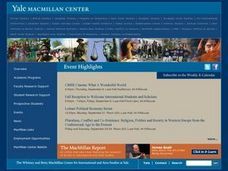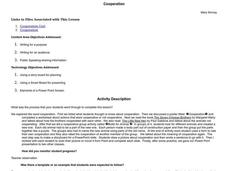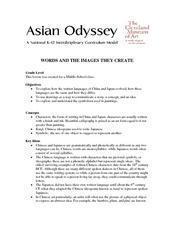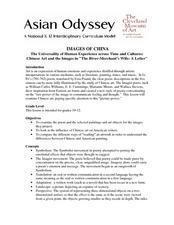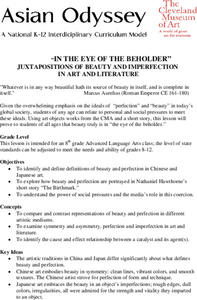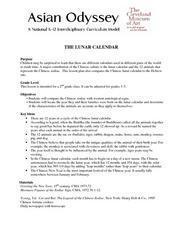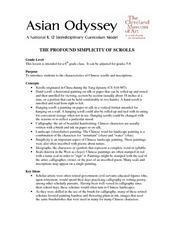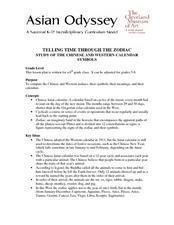Curated OER
Yaks, Yurts, and Yogurt: A Look at China's Autonomous Regions
Pupils are introduced to five Chinese geographical areas. They, in groups, research these areas and develop presentations including information on the physical characteristics, climate, elevation, agriculture and language.
Curated OER
Zhuang: China's Largest Minority
Students, in groups, research Chinese ethnic minorities such as the Zhuang population. They identify the characteristics of different ethnic groups and consider the lives of ethnic groups worldwide.
Curated OER
On the Road with Marco Polo: Marco Polo in China
Young scholars trace Marco Polo's route into China and use the Internet to research major products fabricated in 13th century China. They discuss their findings and write a report on either: silk, porcelain, jade, lacquerware or tea.
Curated OER
Cooperation
Students, in groups, "Build An Animal where they need to cooperate in order to be successful and then make a storyboard for a Powerpoint presentation.
Curated OER
Sharp and Smooth Movements: The Nutcracker
Students explore sharp and smooth movements. In two groups, students perform dances using sharp and smooth movements. They are asked to discuss the differences between the movements and how they felt when you watched or performed.
Curated OER
Words And the Images They Create
Students explore how the written languages of China and Japan evolved, creating representations of Chinese and Japanese Poetry. Emphasis is placed on small, cooperative learning groups.
Museum of Tolerance
Disenfranchised People of the New Nation
Why are some immigrant groups in the United States embraced while others become disenfranchised? To answer this question, teams investigate why groups emigrated to the US, why some of these these peoples were...
Curated OER
Expressing Our Thoughts Through Poetry
Students create a poem on about spring. They read final version of their poem chorally. They write reflections of their experience in creating the poem.
Curated OER
Images of China
Students examine the Chinese poem "The River-Merchant's Wife: A Letter" by Li Po while comparing the different ways of "reading" an artwork in order to understand the differences between Chinese and American painting.
Curated OER
In The Eye Of The Beholder
Learners identify and define definitions of beauty and perfection in Chinese and
Japanese art and compare those definitions to other cultural beliefs and societies. This lesson includes a two-part lesson evaluation.
Curated OER
The Lunar Calendar
Students examine the Chinese calendar and Zodiac signs in this early elementary lesson on calendars and culture. Discussions on cultural beliefs and values are emphasized and could be controversial.
Curated OER
The Profound Simplicity Of Scrolls
Students create art scrolls in the Chinese style using individual examples of landscape pictures and poetry in this instructional activity for the middle-level Language Arts, Social Studies, or Art classroom.
Curated OER
The Three Perfections
Students discover the various styles, form, beauty, and grace of Chinese calligraphy by examining works of art from different eras in China's history. This lesson includes two possible enrichment activities.
Curated OER
Iconography: Art and Literature
Students discover the main subjects and objects of Buddhist art and how symbolism in the Arts can enhance the artistic elements. The lesson plan concludes with the creation of student works using iconography.
Curated OER
Telling Time Through the Zodiac
Students compare the Chinese and Western zodiacs, their symbols, their meanings, and their calendars through a in-class discussion and a small group project. This lesson includes vocabulary and extensions.
Curated OER
Folktales Reflect Daoist and Buddhist Traditions
Tenth graders compare three Chinese folktales for their "messages" and literary techniques to see how they reflect Chinese Confucian and Taoist values. They discuss how folktales share certain subjects, characters, plots and themes.
Curated OER
The Flights Of The Phoenix
Students investigate the use of the Phoenix in Japanese and Chinese art while making connections to the use of the Phoenix in the book Fahrenheit 451. This activity can be adapted for grades 8 through 11 but was originally for 8th grade...
Curated OER
Natural Enemies
Fourth graders engage in the reading of an ancient Chinese fairy tale. The goal of the lesson is for them to become creative in the use of writing. The story creates a context for student's writing and ideas for future drafts.
Curated OER
Wild Swans
Students, watching the movie, "Wild Swans," explore a writer's journey of discovery about her mother, grandmother, and herself. They also study the Chinese culture and history of the last 50 years.
Curated OER
The Role of the Teacher
Students study the role of the teacher in various cultures and societies through in-class discussions, literature investigations, and personal reflection. Lesson extensions include a "Living Portraits" activity and a "Student becomes the...
Curated OER
The Whole World
Students discuss and evaluate the use of the Yin and Yang symbols in Chinese history, making connections to current trends in Chinese culture. Emphasis is placed on small group discussions.
Curated OER
Voices From Your Heart
Students create individual representations of Chinese calligraphy symbols in this cross-curricular lesson for the elementary Language Arts or Art classroom. One enrichment activity is included.
Curated OER
Creative Writing and Analysis
Students read and analyze poems by Li Po and Wang Wei. They answer discussion questions, identify the elements of the poems, examine and discuss Chinese landscape paintings, write an original poem, and write a comparison/contrast essay.
Curated OER
Ink Painting And Poetry In Japan And China
Young scholars create original Haiku poetry and paint images that depict the emotions of each poem in this high school Language Arts instructional activity adaptable for other curriculums including Art and Social Studies.
